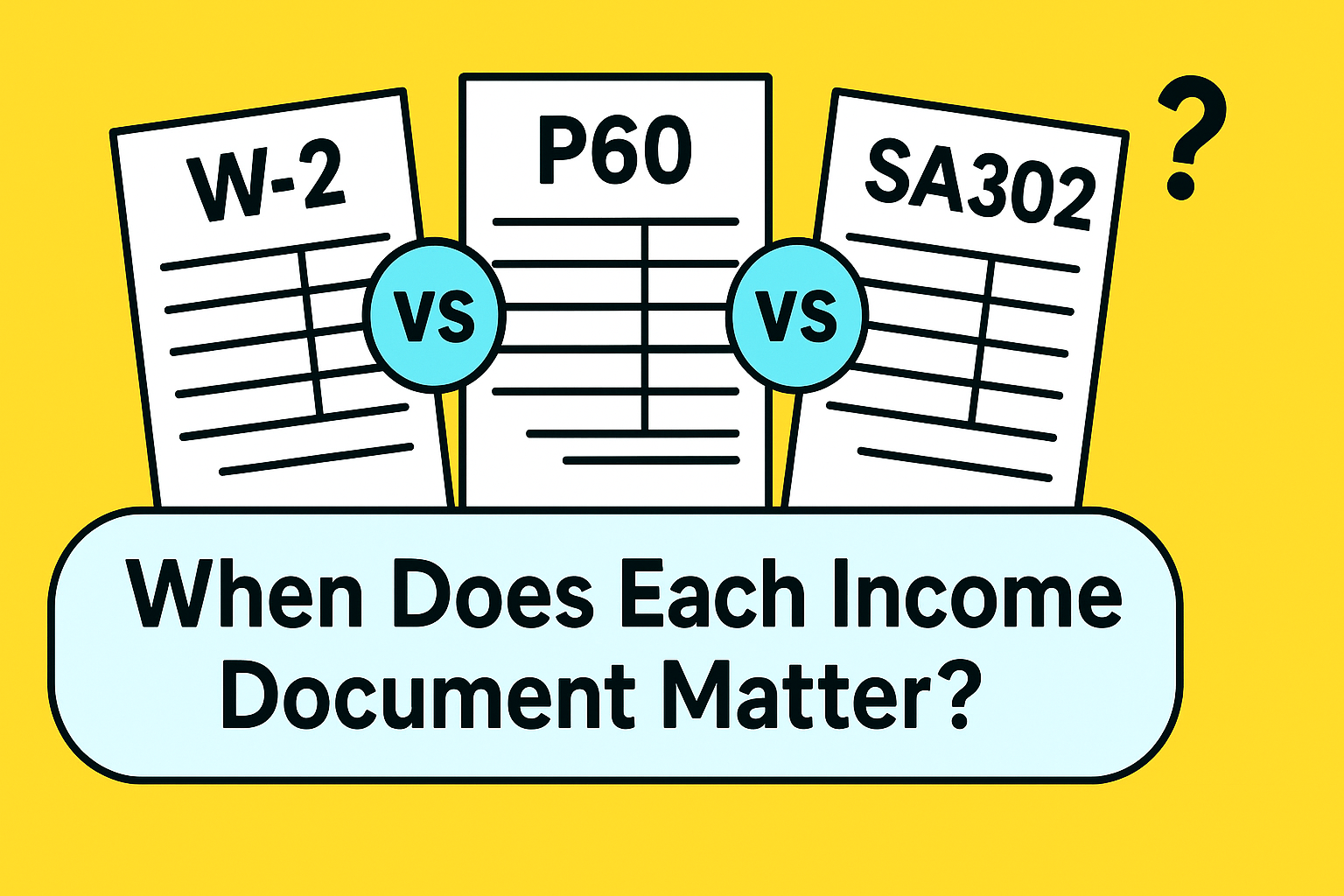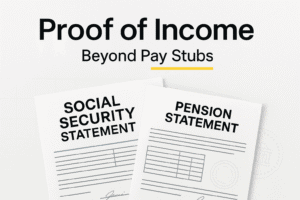Last updated: August 2025
When you apply for housing, loans, visas or other milestones, decision‑makers need clear proof of earnings. Employers, lenders and agencies each have specific documents they expect to see. In the United States, it’s the W‑2; in the United Kingdom, it’s the P60 for employees or the SA302 for self‑employed taxpayers; in Canada it’s the T4 slip and Notice of Assessment. Using the wrong document or submitting it with confusing formatting can delay or even derail your application.
FinancialDocsProvider.com helps by editing and organizing your existing documents so they’re legible, properly bundled and easy to verify. We do not change numbers, dates, names or factual information—our work improves presentation and compliance. This guide explains when each income document matters, what “formatting” vs. “falsification” means, and how to package your file so it passes routine checks in the US, UK and Canada.
Related Entities & Terms
- US forms: W‑2, 1099‑NEC, 1099‑MISC, Schedule C, tax transcript
- UK forms: payslips, P60, P45, SA302 tax calculation, Tax Year Overview
- Canadian forms: T4 slip, Notice of Assessment (NOA), T1 General
- Other documents: pay stubs, bank statements, employment letters, invoices
- Regulators: IRS, CFPB, FTC (US); HMRC, FCA (UK); CRA, FCAC (Canada)
- Concepts: Self Assessment, PAYE, Payroll Year End, CPP/QPP, tax withholding
- Tools: OCR, PDF/A, redaction, metadata clean‑up, audit trails
- Process terms: underwriting, tenancy screening, affordability assessment
Throughout this guide you’ll find links to related resources, such as our post on common proof‑of‑income documents. Our compliance‑first editing ensures your documents meet legal standards without altering the facts.
Law Basics: Document Purposes Across the US, UK & Canada
Understanding the legal purpose of each income document prevents mistakes. Different countries have different forms, deadlines and rules. Below is a summary of how W‑2, P60, SA302 and their Canadian equivalents function.
United States: W‑2 and Wage Verification
A W‑2 (Wage and Tax Statement) is issued by US employers to every employee who had income, Social Security or Medicare tax withheld during the year. Employers must file a W‑2 if they paid an employee at least $600, including non‑cash payments, and withheld any of these taxes. The W‑2 reports total wages, tips, bonuses, taxable benefits and federal, state and local taxes withheld. Employees receive their W‑2s by 31 January following the tax year.
Underwriters often ask for two or three recent pay stubs along with the previous year’s W‑2 to confirm income consistency. The IRS, Consumer Financial Protection Bureau and Federal Trade Commission all emphasize honest reporting; falsifying a W‑2 can lead to civil penalties and, in severe cases, criminal charges.
United Kingdom: P60 End‑of‑Year Statement
In the UK, employers must provide a P60 to each employee by 31 May after the tax year ends. A P60 summarises total pay, income tax deducted, National Insurance contributions and other deductions for the previous tax year. If you have multiple jobs, you’ll receive a separate P60 from each employer. Pension providers also issue P60s to retirees showing tax deducted from private pension payments.
Employees paid via Pay As You Earn (PAYE) use their P60 when applying for mortgages, visas or loans, because it serves as official proof of income and taxes paid. Self‑employed individuals and freelancers do not receive P60s; instead, they rely on the SA302 tax calculation and payslips or invoices. If you suspect any error on your P60, contact your employer or HMRC to correct it.
United Kingdom: SA302 for Self‑Assessment
Self‑employed individuals and company directors in the UK complete a Self Assessment tax return every year. Once the return is filed, HMRC generates an SA302 document (also known as a tax calculation) that shows your total income, allowances, reliefs and the total tax due. You can download your SA302 through your HMRC online account or commercial tax software about 72 hours after submitting your return. Lenders often require SA302s for the last two to four years when assessing self‑employed applicants.
The SA302 is evidence of earnings for freelancers, contractors, sole traders and landlords. It breaks down income from employment, dividends, rental property, interest and other sources. While you can print it yourself, some mortgage lenders prefer copies downloaded directly from your HMRC account or stamped by an accountant. Tampering with figures on an SA302 is illegal; if there’s a mistake, request a correction from HMRC.
Canada: T4 Slip & Notice of Assessment
Canada’s T4 slip serves a similar purpose to the W‑2 and P60. Employers must issue a T4 to any employee from whom they deducted Canada Pension Plan (CPP) or Quebec Pension Plan (QPP) contributions, Employment Insurance (EI) or income tax, or if total remuneration paid during the year exceeded CA$500. The T4 lists salary, wages, tips, bonuses and taxable benefits. Employees usually receive T4 slips by the end of February following the tax year.
Self‑employed Canadians rely on the T1 General tax return and the CRA Notice of Assessment (NOA) as proof of income. Lenders typically ask for NOAs covering the last two years to ensure consistent earnings. Like their American and British counterparts, Canadian regulators such as the CRA and the Financial Consumer Agency of Canada stress the importance of accurate reporting; falsifying a T4 or NOA can lead to serious penalties.

Allowed Edits: When Formatting Is Compliant
Not all changes are prohibited. Improving readability, protecting privacy and organizing files are legitimate tasks. Here are examples of edits we perform for clients without changing the underlying information.
Privacy & Redaction
- Mask personal identifiers by redacting Social Security, National Insurance or Social Insurance numbers, leaving only the last four digits.
- Remove home addresses or phone numbers if the recipient doesn’t need them.
- Blur barcodes or QR codes that reveal internal payroll identifiers.
Legibility & Layout Fixes
- Rotate scanned pages so they’re upright.
- Merge multiple pages into a single PDF for easy review.
- Export directly from your payroll or tax portal to avoid distorted fonts.
- Add bookmarks or a cover page summarizing the contents (“2024 W‑2,” “FY 2024‑25 P60”).
File Format Improvements
- Convert images (JPG/PNG) to PDF to ensure universal compatibility.
- Apply optical character recognition (OCR) so text is searchable.
- Generate PDF/A versions for long‑term archiving.
These adjustments are legal because they improve presentation without altering numbers, dates, employer names or tax identifiers. By making your documents easier to read and verify, you can help decision‑makers process your application more quickly.
Illegal Edits: What Crosses the Line
Altering substantive details in an income document is considered falsification. This can lead to denied applications, fines and even criminal charges. Avoid these actions:
- Changing income amounts. Do not alter wage, bonus or tax withheld figures on W‑2s, P60s, SA302s, T4s or NOAs.
- Adjusting dates. Do not move pay periods or change tax year dates.
- Editing names or employers. Do not substitute employer names, company numbers or payroll numbers.
- Adding fake pages or logos. Do not insert pages that didn’t exist or copy logos from another company.
- Scrubbing audit trails. Do not remove metadata or version history to conceal edits.
Verification tools increasingly detect inconsistencies. Lenders may check numbers against payroll providers, tax authorities or bank deposits. If your documents don’t match official records, your application can be rejected and you may face legal repercussions. If you notice an error on a document, request an official correction rather than trying to fix it yourself.
Use Cases: When W‑2, P60 & SA302 Matter
Knowing which document to provide depends on your situation and the requirements of the party reviewing your application. Here are some common scenarios.
Renters & Tenancy Applications
Landlords need assurance of steady income. For salaried employees in the US, submit your last two or three pay stubs with last year’s W‑2. In the UK, letting agents often ask for three consecutive payslips and the most recent P60. In Canada, prepare several recent pay statements and your T4 slip; many landlords also request bank statements to verify deposit history.
Self‑employed renters—freelancers, contractors, small‑business owners—should provide SA302s (UK) or CRA Notice of Assessment (Canada) from the last two years. Include bank statements and recent invoices or contracts to prove ongoing income. Our post on what landlords want to see contains more tips.
Auto Loans & Consumer Credit
Car dealerships and lenders use income documents to assess your debt‑to‑income ratio. US applicants should expect to supply the most recent W‑2 and a few pay stubs. UK lenders typically request the latest P60 and payslips; some may also ask for P11D forms if you receive benefits in kind. Self‑employed applicants need SA302s from the past two to four years and bank statements. Canadian applicants should provide their T4 and recent Notice of Assessment. See our guide on common mistakes when ordering documents to avoid delays.
Small Business & SBA Loans
For entrepreneurs applying for SBA or small‑business loans, lenders typically require personal income documents alongside business financials. In the US, provide W‑2s or personal tax returns (Form 1040 with Schedule C or K‑1s) to show salary and profit. In the UK, lenders want SA302s and Tax Year Overviews for at least three years, plus a P60 if you pay yourself a salary. In Canada, include your T4 (if salaried) along with your T1 General and recent NOAs. Keep personal and business accounts separate to avoid confusion.
Visa Applications & Mortgages
Visa authorities and mortgage lenders need comprehensive income evidence. US mortgages typically require two years of W‑2s, recent pay stubs and—for self‑employed applicants—two years of personal and business tax returns. UK mortgage lenders usually require three years of SA302s and Tax Year Overviews or the latest P60 if you’re on PAYE. Canadian lenders ask for two years of CRA NOAs. Check whether originals are required or if certified copies suffice.
Self‑Employed Packet Guidance
When you’re self‑employed, demonstrate stability and traceability. A typical packet might include:
- SA302s (UK) or CRA NOAs (Canada) for the last two or three years.
- Six to twelve months of bank statements showing consistent deposits.
- Recent invoices or signed contracts to prove ongoing work.
- A cover letter explaining your business model and income streams.
For more on document choices in specific situations, see our article pay stub vs. bank statement. Make sure your packet tells a consistent story; any discrepancy between bank deposits and tax documents will raise questions.
How We Work: Our Intake‑to‑Delivery Process
We follow a structured process to ensure accuracy, compliance and quick turnaround:
1. Intake & Requirement Gathering
You securely upload your original documents and share who will be reviewing them (landlord, lender, government agency). We never ask for your account credentials, only the files you already have.
2. Reconciliation & Sequence
Our team reviews your files to confirm all required forms are present—such as W‑2s, P60s or SA302s. We cross‑check year‑to‑date figures against total amounts to catch any inconsistencies. If we spot an issue, we notify you so you can resolve it with your employer or tax authority.
3. Formatting & Redaction
We improve readability, merge files, add bookmarks, apply OCR and redact sensitive personal information. For P60s and SA302s, we highlight key figures (such as gross income and tax paid) so reviewers can find them quickly. We never alter amounts, dates or names. Our process aligns with guidelines from the IRS, HMRC and CRA.
4. Delivery & Ongoing Support
We deliver a clean, organized PDF packet within the agreed timeframe—often within 24 hours for simple tasks. If you need further adjustments (such as adding bank statements or documents from other sources), we’re here to assist. Learn more about our proof of income editing and bank statement formatting services.
Checklist: Quick Compliance & Packaging Tips
Use this quick list to ensure your packet is ready for review:
- Gather all documents: Latest pay stubs, W‑2/P60/T4, tax returns and SA302/NOA.
- Check legibility: Ensure every page is clear, upright and readable. Request fresh copies if necessary.
- Verify consistency: Make sure year‑to‑date figures match totals on your tax forms. Resolve discrepancies before submission.
- Redact responsibly: Remove only sensitive identifiers; leave all pay figures, dates and employer names intact.
- Package logically: Arrange documents chronologically or by type. Use bookmarks or a cover sheet for long packets.
- Keep originals: Hold onto original documents in case they are requested later.
For more details, see our post on real customer stories, which shows how proper packaging helped applicants get approved.
Red Flags: Common Mistakes to Avoid
Prevent delays and rejections by steering clear of these pitfalls:
- Mismatched numbers: Inconsistencies between pay stubs and tax documents raise suspicion.
- Outdated forms: Submitting last year’s P60 when the current year’s is required can lead to resubmissions.
- Suspicious edits: Obvious changes to fonts, totals or layouts suggest tampering.
- Missing pages: Always include every page of your P60, SA302 or T4; lenders notice incomplete documents.
- Altered metadata: Do not erase creation dates or authorship; this may trigger digital forensics flags.
- Unsecured sharing: Use encrypted portals rather than email to send sensitive documents.
Many of these issues can be avoided by following our reconciliation and formatting process, or by using professional help before you submit your documents.
Resources & Helpful Links
Access these official and internal resources for further guidance:
- IRS: About Form W‑2 – Employer responsibilities and current revisions.
- GOV.UK: P60 Guidance – Details on what a P60 is and how to get one.
- GOV.UK: SA302 Tax Calculation – How to obtain your tax calculation.
- CRA: T4 Slip Information – Requirements for T4 slips.
- Proof‑of‑income document guide – Formatting tips for various income forms.
- Common document mistakes – Learn what causes delays and rejections.
- Pay stub vs. bank statement – Choosing the right document for your situation.
- What landlords want to see – Rental application tips.
- More about our services: financial document services, pricing, about our process, and contact our team.
FAQs
What is the main difference between a W‑2, P60 and SA302?
A W‑2 is a US wage statement issued by employers showing annual pay and taxes withheld. A P60 is a UK end‑of‑tax‑year statement summarising salary and National Insurance contributions for employees. An SA302 is a self‑assessment tax calculation issued by HMRC for self‑employed individuals and company directors in the UK.
When will a lender or landlord ask for a P60 instead of a SA302?
Lenders and landlords ask for a P60 when you are an employee paid via PAYE because it shows your total income and tax paid for the past tax year. They request an SA302 when you’re self‑employed, a freelancer or have significant other income streams, since it details earnings and tax owed based on your self assessment.
Can Canadians use a T4 slip instead of a W‑2 or P60?
Yes. In Canada, the T4 slip is the equivalent of the W‑2/P60. It shows all remuneration paid by an employer, including wages, bonuses and taxable benefits. Self‑employed Canadians rely on their T1 General return and Notice of Assessment as proof of income.
Is it legal to edit a W‑2, P60 or SA302 for clarity?
You may reformat documents—rotate pages, merge files, add bookmarks, redact sensitive identifiers or convert file formats—as long as you don’t change factual content. Altering amounts, dates, names or tax identifiers is illegal and can result in serious penalties.
How can FinancialDocsProvider.com help me prepare my income documents?
We focus on compliance‑first editing and formatting. Our team reviews your documents, checks for completeness, improves legibility, applies legal redactions and bundles everything into a polished PDF packet. We never fabricate or alter information; our goal is to present your documents clearly and legally.
Need accurate, reliable financial documents fast? Contact FinancialDocsProvider.com now.








Add comment